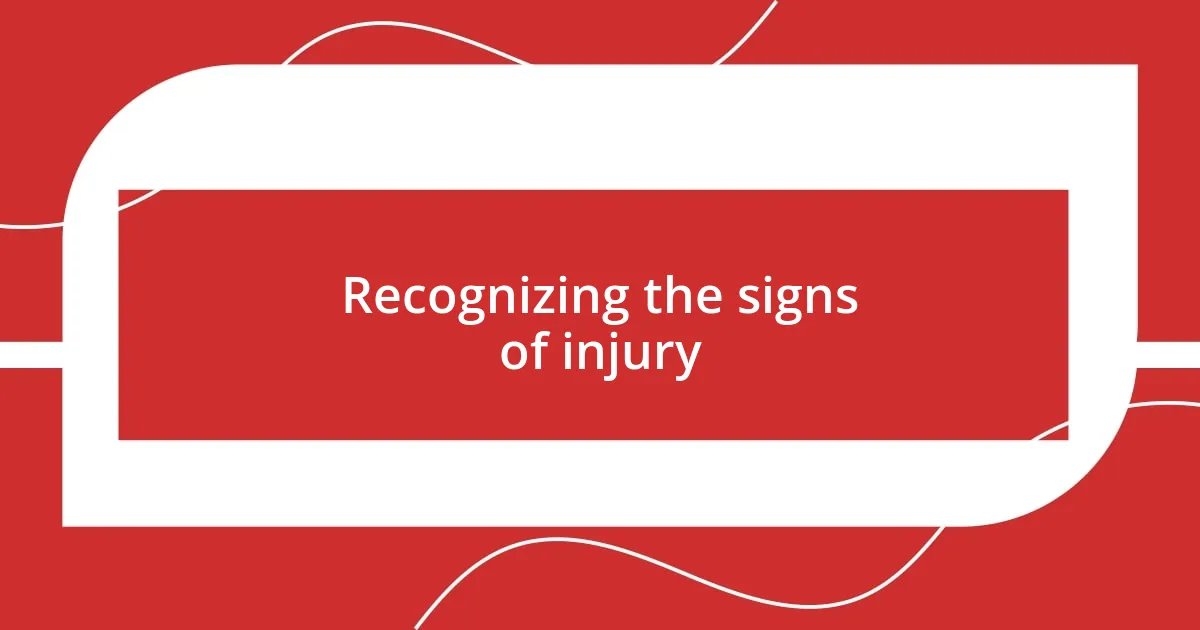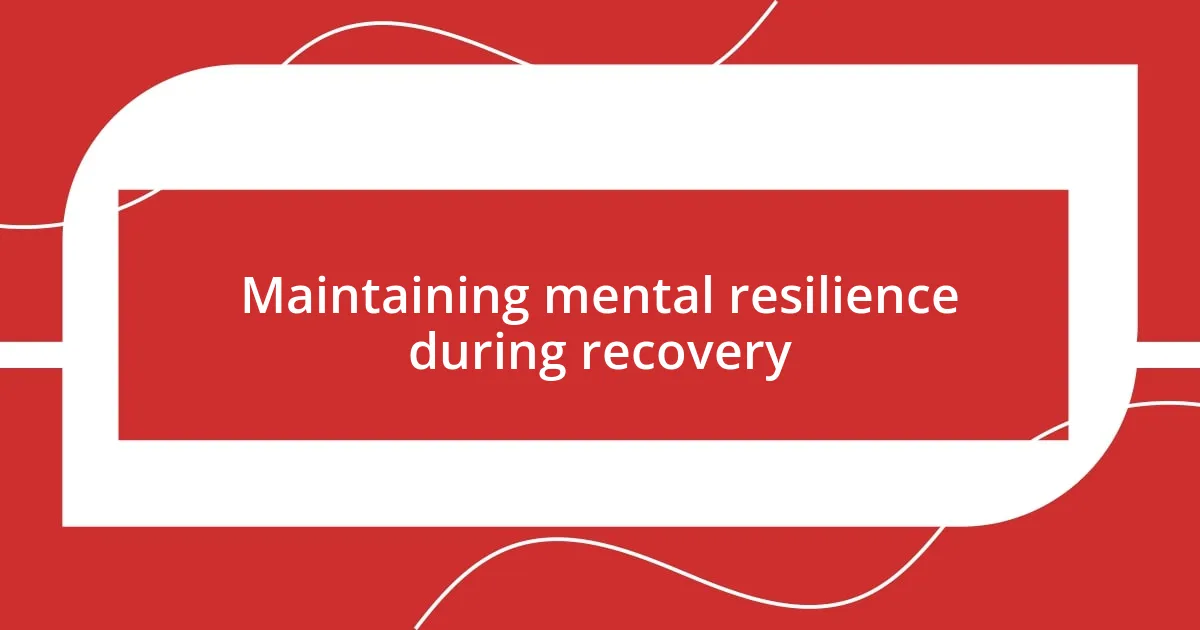Key takeaways:
- Common running injuries include knee pain, Achilles strains, and shin splints, highlighting the importance of understanding the body’s signals for injury prevention.
- Recognizing early signs of injury, such as persistent pain and changes in gait, can prevent serious setbacks and promote smarter training approaches.
- Setting realistic recovery goals, like focusing on small, measurable targets, can boost confidence and facilitate a more effective rehabilitation process.
- Maintaining mental resilience through visualization, journaling, and seeking support from fellow runners is essential for navigating the emotional challenges of recovery.

Understanding common running injuries
Running, while liberating and exhilarating, often comes with its fair share of injuries. I remember when I first felt that familiar ache in my knee; it was disheartening. Knee injuries, like patellofemoral pain syndrome, are common among runners. Have you ever faced that moment when a simple run becomes a painful reminder of limits? It’s frustrating, but understanding these injuries can empower us.
Another common issue is a strained Achilles tendon. I once pushed too hard too quickly and felt a piercing pain in the back of my ankle. The Achilles is sensitive; we hardly think about it until something goes wrong. Isn’t it amazing how our bodies can send us messages that we often ignore? Tuning in is essential.
Then there’s shin splints, an all-too-familiar enemy for many of us. I recall battling through my first half-marathon, only to be sidelined by that throbbing sensation along my shins. It taught me the importance of rest days and proper footwear. Have you experienced this? Learning to listen to my body changed my approach to running completely. Understanding these injuries is the first step to resilience.

Recognizing the signs of injury
Recognizing the signs of injury is something every runner should prioritize. I once brushed off a persistent tightness in my calf, thinking it was just a normal post-run discomfort. But that tightness soon transformed into a debilitating pain, forcing me to take time off. It’s easy to convince ourselves that we’re just being weak, but listening to our bodies can prevent serious setbacks.
To help you identify potential injuries early on, here are key signs to look out for:
– Persistent pain: If pain lingers beyond your post-run recovery, it’s a red flag.
– Swelling or inflammation: Noticeable swelling can indicate an injury that needs attention.
– Reduced performance: Struggling to hit your usual pace or distance can suggest something is off.
– Joint stiffness: If your joints feel stiff or creaky, it might be time for a pause.
– Changes in gait: Altered running form can signify an issue that needs addressing.
I’ve learned the hard way that taking these signs seriously can make all the difference. It’s not just about being tough; it’s about being smart in our approach to injury prevention. After all, our passion for running is worth protecting.

Setting realistic recovery goals
Setting realistic recovery goals is crucial for any runner facing an injury. From my experience, it’s all about finding that sweet spot between ambition and patience. I remember a time when I set my sights on resuming my pre-injury mileage in just a few weeks. It felt achievable, but reality hit hard when my body wasn’t ready. Listening to my body and accepting that recovery takes time was a tough lesson, but it ultimately made my comeback much stronger.
Initially, I set vague goals such as “I want to feel better” without any concrete steps. This left me feeling frustrated every day. I shifted my focus to smaller, measurable targets, like completing gentle workouts or walking for a specific duration. I felt accomplished as I ticked off these goals and, piece by piece, my confidence grew. It became less about just running again and more about reconnecting with my body at its own pace.
Here’s a table that illustrates some examples of recovery goals versus realistic recovery goals based on my own journey:
| Recovery Goals | Realistic Recovery Goals |
|---|---|
| Run 5 miles without pain | Walk for 30 minutes daily without discomfort |
| Resume full workout routine in 2 weeks | Gradually increase running time from 10 minutes every other day |
| Compete in a race next month | Join a recovery group and listen to my body before racing |

Implementing effective rehabilitation techniques
Implementing effective rehabilitation techniques became a game changer for me after my injury. I remember my first session with a physical therapist, who showed me how to strengthen the muscles around my knee gently. It felt like a light bulb moment when I realized that targeted exercises could not only aid recovery but also prevent future issues. Have you ever experienced that blend of hope and skepticism when starting a new rehab routine? That was me, but I embraced every step.
I also integrated cross-training into my recovery plan. I traded some of my running time for low-impact activities like cycling and swimming. I found that these alternatives kept me engaged without straining my injury. Each session was a reminder that staying active wasn’t just about running; it was about nurturing my body as a whole. As I pedaled away on the stationary bike, I often wondered if I’d ever feel the thrill of pounding the pavement again. That uncertainty was tough, yet it drove me to focus on both my mental and physical resilience.
Moreover, incorporating rest into my rehabilitation was a vital lesson I learned the hard way. Initially, I thought pushing through discomfort would speed up my recovery. Instead, I found myself feeling worn down and frustrated. I began scheduling in restorative days, where I focused on yoga and meditation to listen to my body and recalibrate my mindset. How many of us forget that rest is just as integral to recovery as the hard work we put in? Embracing the quiet moments helped me rediscover the joy in simply moving, regardless of the pace.

Gradually returning to running
As I began my gradual return to running, I approached it like a delicate dance. The first few steps outside were filled with anticipation, but I quickly realized I needed to gauge my body’s response. The thrill of feeling the ground beneath my feet again was intoxicating, yet I had to remind myself to stay grounded. Would my knee hold up? Would I struggle with breath fatigue? Each run became a new conversation with my body, where I learned to listen attentively.
I decided to start with short, manageable runs—only ten minutes at a time. I remember that first day, stepping out the door like a cautious child learning to ride a bike. But what surprised me was the overwhelming joy I felt after those ten minutes! It was exhilarating to move, even if it meant slowly rebuilding my endurance. I set a mantra for myself: “Every step counts.” Each run was less about mileage and more about rediscovering my love for running, one breath at a time.
However, there were moments of self-doubt. What if I pushed too hard and ended back at square one? I reflected on those fears each time I felt a twinge of discomfort. Instead of pushing through, I learned it was okay to turn back early. I remember cutting a run short once, feeling a mix of disappointment and relief. The key was to remember that progress isn’t linear; it’s a winding path. Gradually returning to running wasn’t just about the physical act— it became a mental journey of rebuilding trust in my body and my capabilities.

Maintaining mental resilience during recovery
Maintaining mental resilience during recovery was one of my most challenging yet enlightening experiences. I remember staring at my running shoes, collecting dust as I reminded myself that every day without running was a step towards healing. It’s tough to watch others run freely while feeling confined. In those moments, I learned to channel my energy into visualization—imagining myself crossing finish lines and feeling the exhilaration as if I were already there. Have you ever felt that power of positive imagery? It transformed my mindset and kept my spirit lifted.
Journaling became a crucial tool for me during recovery. I poured my thoughts onto the pages, capturing my frustrations and victories alike. There was something cathartic about detailing my journey, like unpacking a heavy backpack after a long hike. I often found myself writing about the small moments of progress, like being able to walk without pain or enjoying a leisurely bike ride. These reflections reminded me that resilience doesn’t always roar; sometimes, it’s a quiet understanding of where you are and where you’re headed.
I also sought support from fellow runners who had faced similar hurdles. Sharing stories with them was like a balm for my frayed nerves. Hearing their tales of triumph against adversity made me realize that I wasn’t alone. We would ask each other questions like, “How did you cope with the frustration?” or “What helped you push forward?” Those conversations felt like a lifeline, grounding me in the understanding that every runner has their battle scars, and it’s those scars that make our journeys uniquely inspiring.















